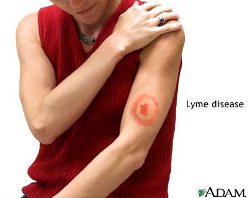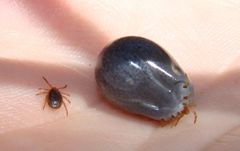
Facts
Deer ticks transmit Lyme disease if they themselves are in fected
by the bacterium Borrelia burgdorferi (B. burgdorferi).
The tick can become infected with this bacterium if it feeds on
an animal that is infected such as deer, mice, and other small
rodents.
Lyme disease can be transmitted to humans if bitten by the
infected deer tick and fed on for 48 hours. Lyme Disease was
first reported in the town of Old Lyme, Connecticut, in 1975.
Many more cases have been reported all over the United States
and the prevalence continues to increase. It is most prevalent
in the Northeast, upper Midwest and along the Pacific coast.
fected
by the bacterium Borrelia burgdorferi (B. burgdorferi).
The tick can become infected with this bacterium if it feeds on
an animal that is infected such as deer, mice, and other small
rodents.
Lyme disease can be transmitted to humans if bitten by the
infected deer tick and fed on for 48 hours. Lyme Disease was
first reported in the town of Old Lyme, Connecticut, in 1975.
Many more cases have been reported all over the United States
and the prevalence continues to increase. It is most prevalent
in the Northeast, upper Midwest and along the Pacific coast.
Lyme disease may be seen in three stages; Primary, secondary, and
tertiary respectively. The signs and symptoms vary depending on the
body part that was first infected. Also, everyone reacts different,
which give more variety to symptoms. However, some common signs are
a noticeable rash that radiates around the bite wound. It often
starts as a small, red bump and can be warm and tender to the touch.
The size of the rash varies with each individual, it can be anywhere
from as small as your fingertip to 12 inches in diameter. The
radiating rings resemble that of a bull’s-eye. The rash is the
most common sign of Lyme disease among infected individuals.
size of the rash varies with each individual, it can be anywhere
from as small as your fingertip to 12 inches in diameter. The
radiating rings resemble that of a bull’s-eye. The rash is the
most common sign of Lyme disease among infected individuals.
Along with the rash, flu-like symptoms may be experienced. Fever,
chills, fatigue, and body aches may occur. With this individuals
might be annoyed with migrating joint pain. The pain increases if
the infection goes untreated. Swelling is also one of the many signs
of Lyme disease. Knees are commonly the most affected joint area
detected however, the joint pain can jump from one joint to another.
Less noticed and reported by individuals, but certainly possible is
neurological problems this is caused by inflammation of the
membranes that sound your brain. This is also know as meningitis,
which can then lead to temporary paralysis of one side of the face
(Bell’s palsy). With this, numbness and/or weakness in limbs have
been reported. The severity can increase resulting in impaired
muscle movement after a few weeks. If left untreated, memory loss,
difficulty concentrating and mood changes may be attributed to later
stages of Lyme disease.
Some ways to prevent Lyme disease:
1. When outdoors,
especially in wooden or tall grassy areas make sure to be properly
clothed. Try to minimize the amount of open skin. Deer ticks are
usually found in warm places and crevices on the human especially in
the back of the neck around the hair line.
2. Do not let pets
wander in wooded and grassy areas as they are a common host. If your
pet is invested with ticks the probability the ticks will find you
is very high.
3. Wear repellent
when outdoors.
4. Become educated
on the prevalence of ticks in your area.
However, if you become a host it is very important to follow proper
tick removal techniques. I’m sure you are aware of the many myths in
how to remove a deer tick such as putting nail polish or alcohol on
the butt of the tick and waiting for it to back out. Or by lighting
a match and then blowing it out and placing the match close to the
ticks posterior end and again allowing it to back itself out.
However, none of these myths are the best way to remove a tick.
When a tick is feeding o n
the skin of a host it has its mouthparts inserted into the dermis of
the skin. If you try to pull the tick out and break the mouthparts
off inside the skin this can still cause irritation. Deer ticks must
feed on a human host for more than 48 hours in order to transmit
Lyme disease. Therefore, if one notices the deer tick within the
first 48 hours of attachment the risk for becoming infected is
lower. The proper way to remove a tick is simply by removing
it with a tweezers of some sort. However, it is very important to
get as close as possible to the mouthparts of the tick with the
tweezers. It is also very important that you do not crush the ticks
body.
n
the skin of a host it has its mouthparts inserted into the dermis of
the skin. If you try to pull the tick out and break the mouthparts
off inside the skin this can still cause irritation. Deer ticks must
feed on a human host for more than 48 hours in order to transmit
Lyme disease. Therefore, if one notices the deer tick within the
first 48 hours of attachment the risk for becoming infected is
lower. The proper way to remove a tick is simply by removing
it with a tweezers of some sort. However, it is very important to
get as close as possible to the mouthparts of the tick with the
tweezers. It is also very important that you do not crush the ticks
body.
For more information on Lyme disease, proper way to remove a tick, what to do when you think there is a possibility for infection please visit MayoClinic.com
To learn more about the website designer Click here
To Main Page
